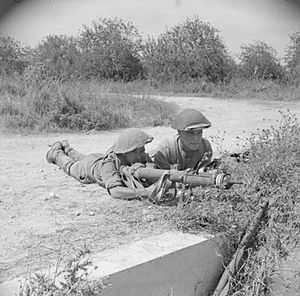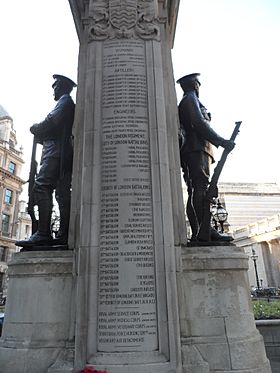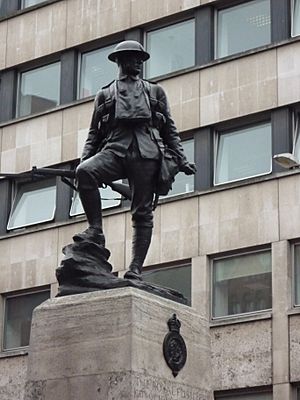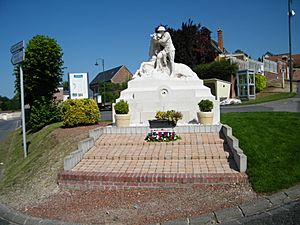2nd (City of London) Battalion, London Regiment (Royal Fusiliers) facts for kids
Quick facts for kids 46th (London & Westminster) Middlesex RVC2nd Volunteer Bn, Royal Fusiliers 2nd Bn, London Regiment 9th Bn, Royal Fusiliers 624 LAA Regiment, Royal Artillery |
|
|---|---|
| Active | 16 April 1861–1 May 1961 |
| Country | |
| Branch | |
| Type | Infantry Battalion Anti-Aircraft Regiment |
| Role | Infantry Air Defence |
| Size | 1–4 Battalions |
| Part of | London Regiment Royal Fusiliers Royal Artillery |
| Garrison/HQ | 9 Tufton Street, Westminster (1899–1937) 213 Balham High Road, Wandsworth (1937–1961) |
| Nickname(s) | 'Second to Nondons' 'Two and Twopennies' (2/2nd Bn) |
| Engagements | |
| Commanders | |
| Notable commanders |
Sir John Shelley, 7th Baronet |
The 2nd (City of London) Battalion, London Regiment (Royal Fusiliers) was a volunteer infantry battalion of the British Army under various titles from 1860 to 1961. It served in Malta, Gallipoli, Egypt and on the Western Front during World War I. In World War II it saw service in Iraq, North Africa and Italy. After a postwar spell as an air defence unit, it reverted to the infantry role, and merged into the Territorials of the Royal Fusiliers.
Contents
Volunteer Force
The enthusiasm for the Volunteer movement following an invasion scare in 1859 saw the creation of many Rifle Volunteer Corps (RVCs) composed of part-time soldiers eager to supplement the Regular British Army in time of need. One such unit was the Royal National Rifles, proposed in August 1860 by Sir John Shelley, 7th Baronet, MP for Westminster, which was to be raised from 'Artisans and other respectable persons'. The prospectus suggested that uniforms would be paid for by a benevolent fund rather than the men themselves. However, there was a protracted controversy over its foundation: the Lord Lieutenant of Middlesex, the Marquis of Salisbury, was opposed to any unit that would 'place upon its class the stamp of inferiority to another' and refused to accept it even when Shelley proposed to change its concept from a purely artisan corps to include clerks from banks, printing houses and lawyers' offices. There were accusations of political prejudice and eventually the Secretary of State for War, Sidney Herbert, was forced to instruct Salisbury to accept the unit in March 1861.
The unit became the 46th (London and Westminster) Middlesex RVC with its first officers commissioned on 16 April. The delay in its formation explains its high number in the Middlesex RVC order of battle. Shelley became its first commanding officer (CO) and its headquarters (HQ) was at 5 Victoria Street, close to Westminster Abbey. By June 1861 the corps had eight companies, four raised in the City of London and four from the City and Liberty of Westminster and the district of Pimlico, and it moved into a larger HQ at 31 Great George Street. The recruits were reported to be from 'the respectable working class' and the officers were 'men of good social position'. The Second-in-Command (appointed 29 January 1862) was Major Lord Stratheden and Campbell, and the adjutant (appointed 26 September 1864) was Robert Beatty Henderson, who had served 19 years as a regular officer in the 21st Foot and the Ceylon Rifle Regiment.
After the initial enthusiasm the number of companies was reduced to six in 1864, reverting to eight in 1878. Lieutenant-colonel Shelley died in 1866 and was succeeded as acting CO by Major Lord Stratheden until Lt-Col F. Burlton Bennett, a former regular officer, was appointed on 19 February 1873. Bennett resigned on 11 November 1874, and Lord Stratheden was promoted to Lt-Col on 9 May 1875. When Lord Stratheden left to become Honorary Colonel of the Central London Rangers in 1876, Maj Robert Routledge, one of the unit's early officers, was promoted to succeed him. At one point seven of Routledge's sons were serving in the corps.The 46th Middlesex gained its own Honorary Colonel in 1877 when Lt-Col Sir Charles Russell, 3rd Baronet, VC, MP for Westminster and formerly of the Grenadier Guards, was appointed to the position. In 1876 the corps' HQ was at Great Smith Street.
When the Cardwell Reforms introduced 'Localisation of the Forces' in 1873, the 46th Middlesex was brigaded, together with several other London and Middlesex Volunteer and Militia battalions, in Brigade No 49 (Middlesex and Metropolitan) under the Royal Fusiliers (City of London Regiment). In 1880, following disbandments and amalgamations among less successful corps, the 46th Middlesex became the 23rd Middlesex RVC. In July 1883 as part of the Childers Reforms it became the 2nd Volunteer Battalion, Royal Fusiliers.
The Stanhope Memorandum of December 1888 proposed a comprehensive Mobilisation Scheme for Volunteer units, which would assemble in their own brigades at key points in case of war. In peacetime these brigades provided a structure for collective training. The battalion formed part of the West London Brigade, together with other VBs of the Royal Fusiliers and Middlesex Regiment, whose place of assembly was Caterham Barracks. In 1899 the battalion moved to a purpose-built HQ at 9 Tufton Street, next to Dean's Yard. An affiliated Cadet Corps was formed at St John's, Smith Square; at one point it was commanded by the Rev William Enderby Lutyens, the 2nd VB's Chaplain.
Second Boer War
After Black Week, the battalion was one of the first units to answer the call for volunteers to serve alongside the regulars in the Second Boer War. A composite Service Company drawn from the 1st, 2nd and 3rd VBs Royal Fusiliers and under the command of Maj W.S. Freidberger of the 2nd VB joined the 2nd Royal Fusiliers on 7 May 1900 at Fourteen Springs. G Company of the City of London Imperial Volunteers (CIV) was also formed from the three Royal Fusiliers VBs. The CIV returned to London when the war seemed over in the summer of 1900, but the service company continued with the regulars during the guerrilla phase of the war. This involved long marches, including the 'Great De Wet Hunt', and then tedious garrison duty in the blockhouse lines. A second composite company joined the 2nd Royal Fusiliers on 22 July 1901, and a third on 1 April 1902. Altogether, four officers and over 150 volunteers from the battalion served in the war, of whom nine were killed or died on active service. The battalion was awarded the Battle honour South Africa 1900–1902.
Territorial Force
When the Volunteer Force was subsumed into the new Territorial Force (TF) under the Haldane Reforms of 1908, the Volunteer units in and around London were formed into a new London Regiment, with the 2nd VB of the Royal Fusiliers becoming the 2nd (City of London) Battalion, the London Regiment (Royal Fusiliers), conveniently shortened to '2nd Londons'. The 1st–4th Bns London Regiment (formerly the 1st–4th VBs Royal Fusiliers) remained brigaded together as 1st London Brigade of the 1st London Division of the TF.
Units of the TF were granted the privilege of carrying Colours if their strength was at least three-quarters of establishment. The 2nd Londons did not qualify, but the battalion began a vigorous recruitment campaign beyond its usual area of Westminster, Pimlico and North Lambeth, and established a new C Company in Willesden and Kilburn, with its HQ at Kingsgate Road, later at the Red Lion Hotel in Kilburn High Road. The unit therefore qualified alongside other battalions of the London Regiment for the presentation of colours at Windsor Castle on 19 June 1909.
World War I
In September 1914, the battalion sailed for Malta and, in January 1915, it was transferred to France.
Gommecourt
The 1/2nd Battalion's first major action was at Gommecourt on the first day of the Battle of the Somme, 1 July 1916, as part of 169th Brigade, 56th (London) Division. The Battalion was in reserve in the morning but, in the early afternoon, was tasked to renew efforts to take the German trenches, an advance of about 200 yards across open ground. It came under heavy machine gun fire from its left flank as well as artillery shelling, and sustained heavy casualties without achieving its objectives. The battalion's casualties at Gommecourt were 4 officers and 41 other ranks (ORs) killed, 6 officers and 159 ORs wounded, 2 officers and 42 ORs missing.
World War II

After the Great War, the battalion resumed its affiliation to the Royal Fusiliers, becoming 9th (2nd City of London) Battalion, The Royal Fusiliers (City of London Regiment). Once again part of 167th (1st London) Brigade, the battalion saw service in World War II, notably in the final stages of the Tunisian campaign in mid-1943, and later in Italy throughout most of the Italian campaign, most notably at Salerno, Anzio, the Gothic Line and later the Spring 1945 offensive in Italy.
Postwar
The battalion was transferred to another corps in 1947, becoming 624th Light Anti-Aircraft Regiment Royal Artillery (Royal Fusiliers). It finally merged with 8th (1st City of London) Battalion, The Royal Fusiliers (City of London Regiment) in 1961 to form The City of London Battalion, Royal Fusiliers (City of London Regiment). That battalion was reduced to company strength in 1967 and is now known as 3 (City of London Fusiliers) Company, London Regiment.
Heritage & ceremonial
Uniforms and insignia
The original uniform of the 46th (London & Westminster) RVC was a drab grey ('Volunteer grey') with green facings, black belt and accoutrements, and a black Shako topped with a green tuft. Officers' uniforms were laced with silver. In 1876 the uniform style was changed from Rifle to Line: the tunic colour became scarlet with blue facings and white belts and accoutrements, the shako blue with a red and white tuft until 1878 when the regulation infantry pattern helmet was adopted. Officers also adopted a frogged undress uniform with a Cheesecutter cap.
After the unit became the 2nd VB, Royal Fusiliers it adopted Fusilier 'grenade' collar badges, but the raccoon-skin Fusilier Cap only slowly replaced the helmet. After the Boer War a white Hackle on the right hand side of the cap was adopted. Silver lace was worn by the officers to distinguish them from regular officers with gold lace; this distinction was dropped when the TF was formed.
Full dress was worn for field training, with the addition of black leggings. Later a simplified red serge tunic with blue facings was adopted for field training, replaced by blue serge and finally khaki service dress in the TF. When the London Regiment was formed in the TF, the battalion was allowed to retain its Royal Fusiliers uniform for full dress. The last time this was worn was at a Royal Review in 1913, when the officers, band and drums still wore the racoon skin cap.
Memorials
The 2nd London Battalion is listed on the City and County of London Troops Memorial in front of the Royal Exchange, with architectural design by Sir Aston Webb and sculpture by Alfred Drury. The right-hand (southern) bronze figure flanking this memorial depicts an infantryman representative of the various London infantry units. Each unit on the memorial was presented with a small bronze plaque; that of the 2nd Londons is at the Army Reserve Centre, 213 Balham High Road.
The battalion is also listed on the pedestal of the Royal Fusiliers War Memorial at Holborn Bar, which is surmounted by a bronze figure of a Fusilier sculpted by Albert Toft. In the absence abroad of the Regular battalions when it was unveiled on 4 November 1922, a composite Guard of Honour formed from the four Territorial battalions paraded under the regimental colour of the 2nd Londons.
The 2nd Londons' own war memorial, a brass tablet and roll of honour was unveiled at the Drill Hall at Tufton Street on 24 June 1922, beneath a tablet of similar design to the dead of the Second Boer War. The memorial is now at the Army Reserve Centre, 213 Balham High Road. The roll of honour is now in the Royal Fusiliers' Regimental Chapel in St Sepulchre-without-Newgate in Holborn,
The 58th Divisional Memorial, depicting a wounded horse sculpted by Henri Gauquie, is at Chipilly. It was paid for from the profits of the divisional entertainment canteen and barber shop.
The regimental colours of the 2nd Londons presented in 1909 are in the Officers' Mess at the Army Reserve Centre in Balham High Road. The King's colour of the 2/2nd Londons presented in 1918 is in St Sepulchre, that of the 3/2nd Londons in the Royal Fusiliers' Museum in the Tower of London.
Battle Honours
The 2nd London Regiment and 9th Royal Fusiliers were awarded the following Battle honours:
Second Boer War:
South Africa, 1900–02
World War I:
Somme, 1916, '18, Albert, 1916, '18, Guillemont, Ginchy, Flers-Courcelette, Morval, Le Transloy, Arras, 1917 '18, Scarpe, 1917 '18, Bullecourt, Ypres, 1917 Langemarck, 1917, Menin Road, Polygon Wood, Passchendaele, Cambrai, 1917, St Quentin, Villers Bretonneux, Amiens, Bapaume, 1918, Hindenburg Line, Épehy, Canal du Nord, Valenciennes, Sambre, France and Flanders 1915–18, Gallipoli 1915–16, Egypt, 1915–16.
World War II:
Djebel Tebega, North Africa 1943, Salerno, St Lucia, Battipaglia, Teano, Monte Camino, Garigliano Crossing, Damiano, Anzio, Gothic Line, Coriano, Croce, Valli di Comacchio, Argenta Gap, Italy 1943–45
The honours in bold were those chosen to be emblazoned on the King's colour.
Honorary Colonels
The following served as Honorary Colonel of the regiment:
- Lt-Col Sir Charles Russell, 3rd Baronet, VC, formerly Grenadier Guards, appointed 2 July 1877, died 14 April 1883.
- Field Marshal Viscount Wolseley, appointed 1 May 1883, resigned 1906.
- Col Albert L. Keller, VD, former CO, appointed 16 December 1906, died August 1907.
- Lt-Col Philip Carlebach, CMG, TD, former CO, appointed 17 December 1910.
- Col Viscount Wakefield, GCVO, CBE, TD, former Lord Mayor of London, appointed 28 May 1921.
Other prominent members
- Sir John Shelley, 7th Baronet, MP, first CO.
- William Campbell, 2nd Baron Stratheden and Campbell, 2iC and twice acting CO.
- H. O. Arnold-Forster, former Secretary of State for War.
- Billy Cotton, future bandleader; served at Gallipoli and later commissioned into the Royal Flying Corps.




